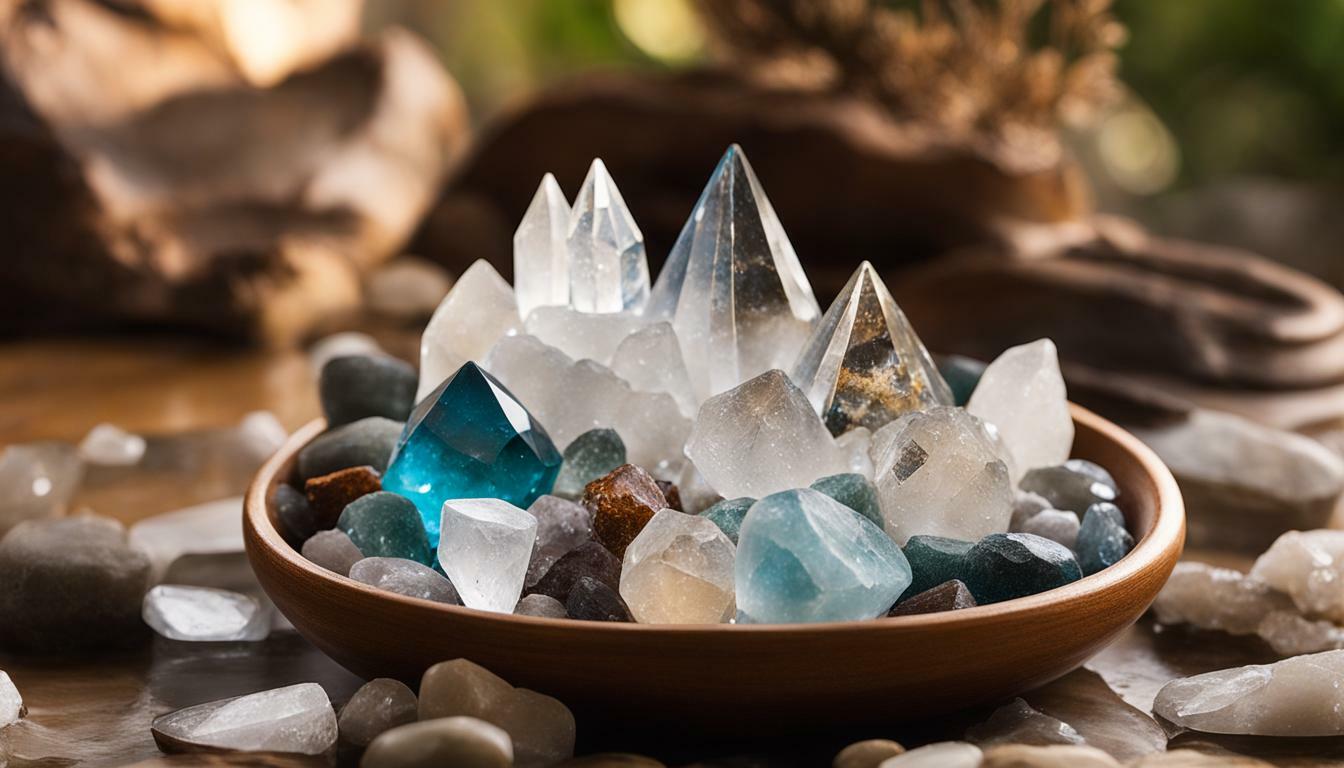Discover which crystals should not be submerged in water to protect your precious collection.
Key Takeaways:
- Not all crystals are safe to be placed in water due to their brittleness, low Mohs scale rating, or chemical composition.
- Crystals with a Mohs rating of 5 or below should be kept out of water as they can dissolve, crack, or release toxins.
- Examples of crystals that cannot go in water include Fluorite, Black Tourmaline, Aquamarine, Turquoise, Pyrite, Ruby, Moonstone, Lapis Lazuli, Malachite, and Selenite.
- Research the water tolerance of your crystals before cleaning or charging them with water.
- Alternative methods like using smoke, sound, moonlight, or salt can be used to energetically cleanse and recharge crystals that are not suitable for water.
Crystal Care: Water Compatibility
Crystal care is crucial when it comes to water compatibility, as certain crystals may be vulnerable to water-related risks. While water can be a powerful cleansing and charging tool for many crystals, it is important to understand which crystals should not come into contact with water due to their properties and composition. Before using water for crystal care, it is essential to research the water tolerance of your specific crystals to avoid potential damage or adverse reactions.
One factor to consider is the Mohs scale rating of a crystal. The Mohs scale measures a mineral’s hardness and its resistance to being scratched. Crystals with a low Mohs scale rating, typically 5 or below, are more susceptible to damage when exposed to water. These crystals can dissolve, crack, or release toxins when immersed in water. Examples of crystals that should not be submerged in water include Fluorite, Black Tourmaline, Aquamarine, Turquoise, Pyrite, Ruby, Moonstone, Lapis Lazuli, Malachite, and Selenite.
However, there are alternative methods for cleansing and charging crystals that are not suitable for water. You can use smoke, sound, moonlight, or salt to energetically cleanse and recharge these crystals without the risk of water damage. These methods can be just as effective and provide a safe way to maintain the energy and vitality of your crystals.
| Crystals Not Safe for Water | Reason for Water Intolerance |
|---|---|
| Fluorite | Dissolves and loses its luster in water. |
| Black Tourmaline | Contains iron and can oxidize or rust when submerged in water. |
| Aquamarine | Can dissolve or become cloudy when exposed to water. |
| Turquoise | Porous and can absorb water, leading to discoloration or damage. |
| Pyrite | Can oxidize and form sulfuric acid when exposed to water. |
| Ruby | Brittle and can crack or chip when submerged in water. |
| Moonstone | Sensitive to water and can lose its iridescent glow. |
| Lapis Lazuli | Contains pyrite and can oxidize when exposed to water. |
| Malachite | Contains copper and can release toxins when in contact with water. |
| Selenite | Soft and water-soluble, can dissolve or erode when exposed to water. |
Remember, crystal care is not a one-size-fits-all approach. It is essential to consider the individual characteristics of your crystals and their compatibility with water. By understanding which crystals to keep away from water and exploring alternative cleansing methods, you can maintain the beauty and energy of your crystal collection.
Crystals with Low Mohs Scale Rating
Crystals with a low Mohs scale rating should be handled with caution around water, as their delicate nature can lead to damage or dissolution. The Mohs scale is a measure of mineral hardness, ranging from 1 (softest) to 10 (hardest). Crystals with a rating of 5 or below are more susceptible to the effects of water, making them unsuitable for water cleansing or charging.
One example of a crystal that cannot go in water is Fluorite, which has a Mohs rating of 4. Despite its beautiful colors and energetic properties, Fluorite should be kept dry to avoid mineral dissolution or cracking. Black Tourmaline, another popular crystal for protection and grounding, also falls into this category with a Mohs rating of 7-7.5. Water can cause it to become brittle and prone to damage.
Aquamarine, known for its calming energy, should also be kept away from water due to its Mohs rating of 7.5-8. Although it is named after the ocean, Aquamarine can be damaged by prolonged exposure to water. Turquoise, a cherished stone for its vibrant blue-green hues, is particularly vulnerable with a Mohs rating of 5-6. It can absorb water, becoming discolored or developing cracks over time.
Pyrite, also known as Fool’s Gold, should be kept dry to prevent chemical changes that can occur when it comes into contact with water. Ruby, Moonstone, Lapis Lazuli, Malachite, and Selenite are other examples of crystals that should not be submerged in water due to their composition or low Mohs scale rating.
| Crystal | Mohs Scale Rating |
|---|---|
| Fluorite | 4 |
| Black Tourmaline | 7-7.5 |
| Aquamarine | 7.5-8 |
| Turquoise | 5-6 |
| Pyrite | – |
| Ruby | – |
| Moonstone | – |
| Lapis Lazuli | – |
| Malachite | – |
| Selenite | – |
Examples of Crystals that Cannot Go In Water
It’s important to be aware of specific crystals that should never come into contact with water, such as Fluorite, Black Tourmaline, Aquamarine, Turquoise, Pyrite, Ruby, Moonstone, Lapis Lazuli, Malachite, and Selenite. These crystals have properties and compositions that make them unsuitable for water cleansing or charging. Let’s take a closer look at each of these crystals and why they should be kept away from water.
| Crystal | Reason for Water Intolerance |
|---|---|
| Fluorite | Fluorite is a relatively soft crystal that can dissolve or pick up moisture from water, leading to damage or discoloration. |
| Black Tourmaline | Black Tourmaline is highly brittle and can easily crack or break when exposed to water due to its delicate structure. |
| Aquamarine | Aquamarine is known for its sensitivity to heat and chemicals, including water. It can lose its color or become damaged when submerged. |
| Turquoise | Turquoise is a porous stone that absorbs liquids, including water, which can cause it to change color, crack, or even disintegrate. |
| Pyrite | Pyrite is an iron sulfide mineral that can react with water to produce sulfuric acid, leading to the formation of a yellowish crust or a rotten egg smell. |
| Ruby | Ruby is a stone that should not be exposed to water, as it can develop surface pits or fractures due to its susceptibility to chemical reactions. |
| Moonstone | Moonstone is a feldspar mineral that is prone to cracks and discoloration when in contact with water, making it unsuitable for water use. |
| Lapis Lazuli | Lapis Lazuli is a composite stone that contains pyrite and calcite, both of which can be damaged by water, causing the stone to deteriorate. |
| Malachite | Malachite is a copper carbonate mineral that is highly soluble in water, making it prone to dissolving or losing its vibrant green color. |
| Selenite | Selenite is a soft and fragile crystal that should never be exposed to water, as it can dissolve, melt, or lose its luster. |
To ensure the longevity and integrity of these crystals, it is best to avoid exposing them to water. Instead, consider using alternative methods like smoke, sound, moonlight, or salt for cleansing and recharging. Remember, each crystal has its own unique qualities and requirements, so always research and understand the water tolerance of your crystals before using water-based methods.
Alternative Methods for Cleansing Crystals
If your crystals cannot go in water, there are alternative methods available to cleanse and recharge their energies. These methods can be just as effective and offer a variety of options to suit your preferences and needs.
Sage Smudging
One popular method is sage smudging, which involves burning dried sage leaves and using the smoke to cleanse your crystals. Simply pass your crystals through the smoke, allowing the purifying energy to remove any negative vibrations. Sage smudging is believed to have a powerful cleansing effect and can be done regularly to keep your crystals energetically clear.
Sound Cleansing
Another option is sound cleansing, which involves using sound vibrations to clear the energy of your crystals. You can use tools such as singing bowls, bells, or even your own voice to create harmonious sounds. Gently strike or play the instrument near your crystals, allowing the vibrations to resonate and restore their energy. Sound cleansing can be a soothing and effective method for purifying crystals.
Moonlight Charging
If you prefer a more natural approach, moonlight charging is a great option. Simply place your crystals outside or near a window during a full moon and allow them to absorb the moon’s energy overnight. This gentle and rejuvenating method is especially beneficial for crystals associated with intuition, healing, and feminine energy.
Remember, it is important to research the water tolerance of your crystals before cleaning or charging them with water. By exploring alternative methods such as sage smudging, sound cleansing, and moonlight charging, you can safely and effectively cleanse and recharge your crystals’ energies for optimal use in your healing practices.
| Method | Description |
|---|---|
| Sage Smudging | Burning dried sage leaves to cleanse crystals using the smoke. |
| Sound Cleansing | Using sound vibrations from singing bowls, bells, or voice to clear crystal energy. |
| Moonlight Charging | Placing crystals outside or near a window during a full moon to absorb its energy. |
Conclusion
Understanding the compatibility of crystals with water is essential to preserve the integrity and energy of your precious collection. By being aware of which crystals cannot go in water and utilizing alternative cleansing methods, you can ensure the longevity and effectiveness of their healing properties.
Crystals that have a low Mohs scale rating, such as Fluorite, Black Tourmaline, Aquamarine, Turquoise, Pyrite, Ruby, Moonstone, Lapis Lazuli, Malachite, and Selenite, should be kept away from water. Their brittleness or chemical composition can make them susceptible to damage, dissolution, or the release of toxins when exposed to water.
When it comes to crystal care, it is important to research the water tolerance of your crystals before cleaning or charging them with water. Avoid submerging crystals with a Mohs rating of 5 or below, as they can crack, dissolve, or undergo unwanted chemical reactions. Instead, opt for alternative methods such as using smoke, sound, moonlight, or salt to energetically cleanse and recharge your crystals.
By taking these precautions and understanding the crystals safe for water, you can ensure the longevity and effectiveness of your crystal healing practice. So, before you reach for that bowl of water, be sure to check which crystals can go in, and which ones should stay dry!
FAQ
Which crystals cannot go in water?
Certain crystals should not be put in water due to their brittleness, low Mohs scale rating, or chemical composition. Crystals that have a Mohs rating of 5 or below should be kept out of water as they can dissolve, crack, or release toxins.
What are some examples of crystals that cannot go in water?
Some examples of crystals that cannot go in water include Fluorite, Black Tourmaline, Aquamarine, Turquoise, Pyrite, Ruby, Moonstone, Lapis Lazuli, Malachite, and Selenite.
Why can’t these crystals be put in water?
These crystals have properties that make them susceptible to damage or dissolution when exposed to water. Their brittleness, low Mohs scale rating, or chemical composition can lead to cracks, dissolution, or the release of toxins.
What should I do if I want to cleanse or charge these crystals?
It is important to research the water tolerance of crystals before cleaning or charging them with water. If a crystal is not suitable for water, alternative methods such as smoke, sound, moonlight, or salt can be used to energetically cleanse and recharge the crystals.
What is the best way to take care of crystals and water compatibility?
When it comes to crystal care and water compatibility, it is crucial to be aware of the potential risks associated with water exposure. Researching the water tolerance of crystals and opting for alternative cleansing methods when necessary can help maintain the integrity and energy of the crystals.








